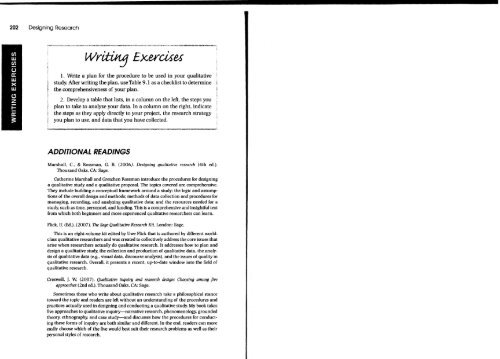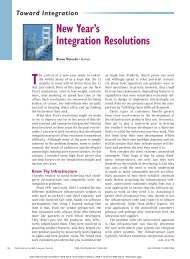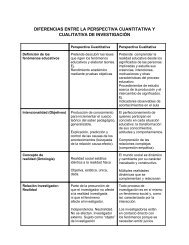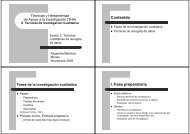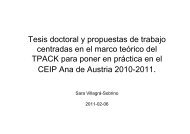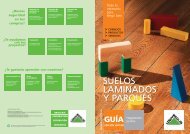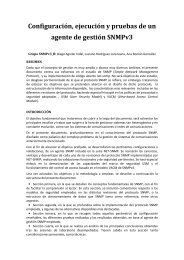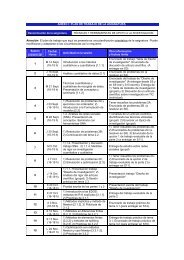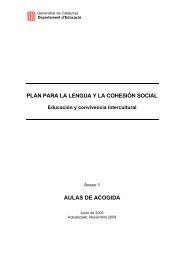Research Questions and Hypotheses
Research Questions and Hypotheses
Research Questions and Hypotheses
Create successful ePaper yourself
Turn your PDF publications into a flip-book with our unique Google optimized e-Paper software.
202 Designing <strong>Research</strong><br />
U)<br />
w<br />
tiJ<br />
1-::<br />
E 1<br />
Wrdtl,P9 Exarci.su<br />
Write a plan for the procedure to be used in your qualitative<br />
study. After writing the plan, use Table 9.1 as a checklist to determine<br />
the comprehensiveness of your plan.<br />
Develop a table that lists, in a column on the left, the steps you<br />
plan to take to analyze your data. In a column on the right, indicate<br />
the steps as they apply directly to your project, the research strategy<br />
you plan to use, <strong>and</strong> data that you have collected.<br />
pm<br />
ADDITIONAL READINGS<br />
Marshall, C., & Rossman, G. B. (2006). Designing qualitative research (4th ed.).<br />
Thous<strong>and</strong> Oaks, CA: Sage.<br />
Catherine Marshall <strong>and</strong> Gretchen Rossman introduce the procedures for designing<br />
a qualitative study <strong>and</strong> a qualitative proposal. The topics covered are comprehensive.<br />
They include building a conceptual framework around a study; the logic <strong>and</strong> assumptions<br />
of the overall design <strong>and</strong> methods; methods of data collection <strong>and</strong> procedures for<br />
managing, recording, <strong>and</strong> analyzing qualitative data; <strong>and</strong> the resources needed for a<br />
study, such as time, personnel, <strong>and</strong> funding. This is a comprehensive <strong>and</strong> insightful text<br />
from which both beginners <strong>and</strong> more experienced qualitative researchers can learn.<br />
Flick, U. (Ed.). (2007). The Sage Qualitative <strong>Research</strong> Kit. London: Sage.<br />
This is an eight-volume kit edited by Uwe Flick that is authored by different worldclass<br />
qualitative researchers <strong>and</strong> was created to collectively address the core issues that<br />
arise when researchers actually do qualitative research. It addresses how to plan <strong>and</strong><br />
design a qualitative study, the collection <strong>and</strong> production of qualitative data, the analysis<br />
of qualitative data (e.g., visual data, discourse analysis), <strong>and</strong> the issues of quality in<br />
qualitative research. Overall, it presents a recent, up-to-date window into the field of<br />
qualitative research.<br />
Creswell, J. W. (2007). Qualitative inquiry <strong>and</strong> research design: Choosing among five<br />
approaches (2nd ed.). Thous<strong>and</strong> Oaks, CA: Sage.<br />
Sometimes those who write about qualitative research take a philosophical stance<br />
toward the topic <strong>and</strong> readers are left without an underst<strong>and</strong>ing of the procedures <strong>and</strong><br />
practices actually used in designing <strong>and</strong> conducting a qualitative study. My book takes<br />
five approaches to qualitative inquiry—narrative research, phenomenology, grounded<br />
theory, ethnography, <strong>and</strong> case study—<strong>and</strong> discusses how the procedures for conducting<br />
these forms of inquiry are both similar <strong>and</strong> different. In the end, readers can more<br />
easily choose which of the five would best suit their research problems as well as their<br />
personal styles of research.


